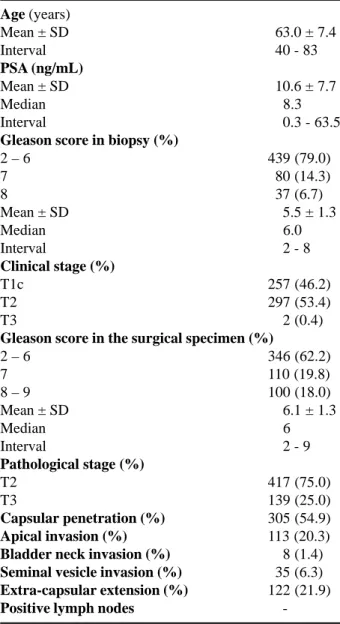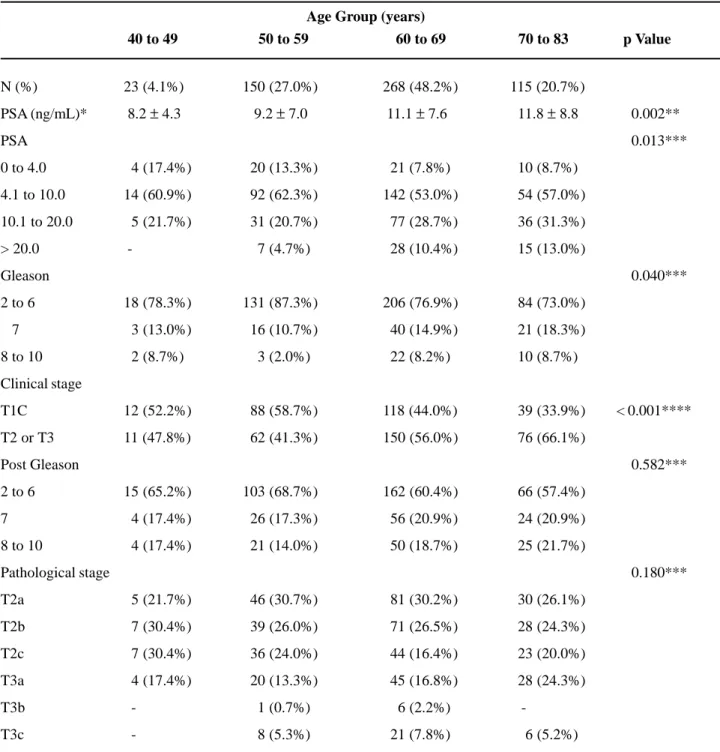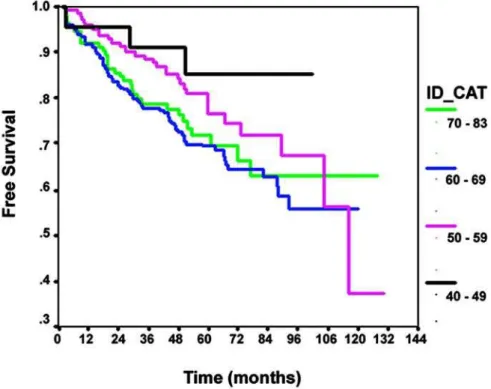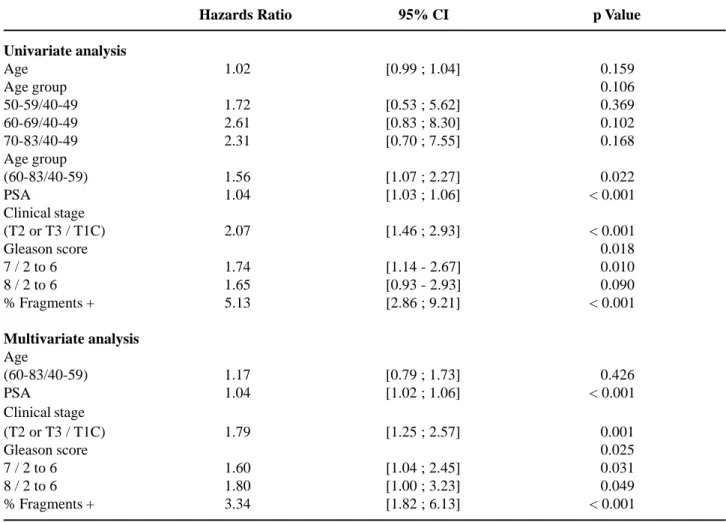Age Impact in Clinicopathologic Presentation and the Clinical
Evolution of Prostate Cancer in Patients Submitted to Radical
Prostatectomy
Alberto A. Antunes, Alexandre Crippa, Marcos F. Dall’Oglio, Luciano J. Nesrallah, Katia R.
Leite, Miguel Srougi
Department of Urology, University of Sao Paulo (USP), and Department of Pathology, Syrian
Lebanese Hospital, Sao Paulo, Brazil
ABSTRACT
Objective: To assess the influence of age in pathological findings and clinical evolution of prostate cancer in patients
treated with radical prostatectomy.
Materials and Methods: Five hundred and fifty-six patients operated on between 1991 and 2000 were selected. Patients
were divided into age groups of between 10 and 49 years, 50 to 59 years, 60 to 69 years and 70 to 83 years.
Results: Patients having less than 60 years of age presented clinical stage (p = 0.001), PSA (p = 0.013) and biopsy Gleason
score (p = 0.013) more favorable than older patients. Age groups did not show any relationship between either postopera-tive Gleason score or pathological stage or risk of non-confined organ disease and involvement of seminal vesicles. After a mean follow-up of 58.3 months, 149 (27%) patients presented recurrence. Patients aged between 40 and 59 years pre-sented a disease-free survival rate significantly higher when compared to patients aged between 60 and 83 years (p = 0.022). However, when controlled with clinical stage, PSA, Gleason score and percentage of positive fragments, there was no relationship between age and biochemical recurrence risk (p = 0.426).
Conclusions: Even though younger patients presented more favorable preoperative characteristics, postoperative
patho-logical findings and biochemical recurrence rates did not differ between studied age groups.
Key words: prostatic neoplasms; age groups; recurrence; survival analysis Int Braz J Urol. 2006; 32: 48-55
INTRODUCTION
The ideal treatment for localized prostate cancer (PCa) is based on individual characteristics of each patient. Presently, clinical staging (1), Gleason score from the biopsy (2) and the serum prostate-specific antigen (PSA) are the prognostic indicators that are mostly used to prevent the risk of an organ-confined disease and tumor progression after treatment (3).
The direct relationship between age and life expectancy and the different biological characteris-tics of cancer in younger men shows the need for improved knowledge of the behavior of tumors in those patients (4,5). We know that even though many cases present an inexpressive behavior during the first 10 to 15 years of evolution, progression-free, metasta-sis-free and specific disease-free survival rates are significantly reduced after this follow-up period (6). Because of this, the early institution of a more ag-gressive treatment could be the most appropriate ap-proach in younger patients with life expectancies higher than 10 to 15 years (7), even though biologi-cal characteristics of PCa in younger patients are little understood (8,9). While previous studies point to a relationship between younger men and more advanced tumors, which suggests that those would not be ideal candidates for radical prostatectomy (RP) (10-12), more recent studies, show that younger individuals present a larger probability of organ-confined tumors and higher disease control rates when submitted to RP (4,8,9).
The objective of the present study is to as-sess the influence of age in pathological findings and the clinical evolution of prostate cancer in patients treated with RP.
MATERIALS AND METHODS
In the period from 1991 to 2000, 556 PCa patients treated with RP and bilateral pelvic lym-phadenectomy at our institution were selected. All patients presented suspicion of organ-confined tumors because of elevation in the PSA or location of a pal-pable nodule during digital rectal examinations. They were diagnosed through a transrectal ultrasound-guided (TRUS) prostate biopsy. Surgical procedures were performed by the same surgeon and pathologi-cal analysis performed by the same pathologist.
During the staging period, patients were sub-mitted to a clinical history of the disease and a physi-cal exam, PSA, computerized tomography of the pel-vis, bone scintigraphy and TRUS. Clinical staging was determined through the AJCC (American Joint Com-mittee on Cancer, 1992) system (1), and the tumor
grade was determined by the Gleason score system (2).
Pre- and postoperative characteristics of the 556 patients are listed in Table-1. The mean age was 63 years (40 to 83), and the mean PSA was 10.6 ng/ mL (0.3 to 63.5). Seventy-nine percent of the patients presented Gleason score of 6 or less in the biopsy, and 53% presented clinical stage T2. After a patho-logical analysis of the surgical specimen, 75% of the patients were classified as bearers of a organ-confined
Age (years)
Mean ± SD 063.0 ± 7.4
Interval 040 - 83
PSA (ng/mL)
Mean ± SD 010.6 ± 7.7
Median 008.3
Interval 000.3 - 63.5
Gleason score in biopsy (%)
2 – 6 439 (79.0)
7 080 (14.3)
8 037 (6.7)
Mean ± SD 005.5 ± 1.3
Median 006.0
Interval 002 - 8
Clinical stage (%)
T1c 257 (46.2)
T2 297 (53.4)
T3 002 (0.4)
Gleason score in the surgical specimen (%)
2 – 6 346 (62.2)
7 110 (19.8)
8 – 9 100 (18.0)
Mean ± SD 006.1 ± 1.3
Median 006
Interval 002 - 9
Pathological stage (%)
T2 417 (75.0)
T3 139 (25.0)
Capsular penetration (%) 305 (54.9)
Apical invasion (%) 113 (20.3)
Bladder neck invasion (%) 008 (1.4)
Seminal vesicle invasion (%) 035 (6.3)
Extra-capsular extension (%) 122 (21.9)
Positive lymph nodes
-Table 1 – Pre-and postoperative clinical and pathological
tumor (pT2), with no patient presenting lymph nodes involvement.
During the postoperative period, patients were assessed every 2 months for a year, every 6 months for up to 5 years and annually thereafter. During each visit, a digital rectal examination and a PSA analysis were performed. The biochemical re-currence of the disease was defined as a PSA equal to or higher than 0.4 ng/mL (13).
Patients were divided into 4 groups accord-ing to age: group 1 – from 40 to 49 years of age (23 patients); group 2 – from 50 to 59 years of age (150 patients); group 3 –from 60 to 69 years of age (268 patients); and group 4 – from 70 to 83 years of age (115 patients). They were further analyzed accord-ing to pre-and postoperative clinical and pathologi-cal characteristics, as well as biochemipathologi-cal recur-rence.
To analyze preoperative variables according to the age groups ANOVA, chi-square and likelihood ratio tests were utilized. The PSA was assessed as a continuous and categorical variable through logarith-mic transformation. Clinical stage, Gleason scores and pathological stage were used as categorical variables. To analyze the prognostic value of age in the deter-mination of the finding of a non organ-confined dis-ease and the involvement of seminal vesicles, a model of logistic regression with adjusted proportional risks was utilized. In this case, age was analyzed as a con-tinuous variable. The non organ-confined disease was defined as pT3 stage. An analysis of biochemical re-currence-free survival rates was performed through the Cox regression model. The Kaplan-Meier method was utilized to estimate survival rate curves, and to compare them the Breslow test was used. Statistical significance was considered as a p ≤ 0.05.
RESULTS
Table-2 shows the main preoperative clini-cal and pathologiclini-cal characteristics in relation to age group. The majority of assessed patients belonged to the 60 to 69 year age group; only 4.1% of the patients assessed were in the 40 to 49 year age group. In rela-tion to PSA, it was observed that no patient in the 40 to 49 year age group presented a PSA higher than 20
ng/mL. It was also observed that there was no sig-nificant change in PSA values in the distribution of patients from the 40 to 49 and 50 to 59 year age groups (p = 0.724). The same thing occurred between the 60 to 69 and 70 to 83 year age groups (p = 0.729). That is, the distribution of PSA values presented a statisti-cally significant differences between the 40 to 59 and 60 to 83 year age groups (p = 0.001). As for Gleason score, we observed the same PSA behavior; i.e., sta-tistically equal distributions between the 40 to 49 and 50 to 59 year age groups (p = 0.288), and between the 60 to 69 and 70 to 83 year age groups (p = 0.695). That is, the distribution of Gleason score presented a statistically significant difference between the 40 to 59 and 60 to 83 year age groups (p = 0.007). In rela-tion to clinical stage, we once again observed behav-iors similar to those reported previously; i.e., similar distributions for the 40 to 49 and 50 to 59 year age groups s (p = 0.557) and the 60 to 69 and 70 to 83 year age groups (p = 0.065). It is interesting to ob-serve the apparent trend in the 70 to 83 year age group, which presents a higher percentage of patients with clinical stage T2 or T3 when compared to the 60 to 69 year age group; however this was only marginally significant (p = 0.065). In relation to postoperative pathological characteristics, we have observed that both Gleason score (p = 0.582) and pathological stage (p = 0.180) did not present associations to age groups. In univariate logistic regression analysis, the age analyzed as a continuous variable showed to be statistically significant in determining the risk of the non organ-confined disease (pT3); however it failed in determining the risk of compromising seminal vesicles OR - 1.03; IC 95% [1.00 ; 1.06], p = 0.032 e OR - 1.03; IC 95% [0.979 ; 1.08], p = 0.281 respec-tively. However, when controlled by other preopera-tive variables, age did not appear to be capable of predicting those pathological findings.
the 40 to 59 year age group presented a higher dis-ease-free survival rate (p = 0.039). When we analyzed the risk of biochemical recurrence through the Cox
Table 2 – Clinicopathologic characteristics according to age group.
N (%) 23 (4.1%) 150 (27.0%) 268 (48.2%) 115 (20.7%)
PSA (ng/mL)* 8.2 ± 4.3 9.2 ± 7.0 11.1 ± 7.6 11.8 ± 8.8 000.002**
PSA 000.013***
0 to 4.0 04 (17.4%) 020 (13.3%) 021 (7.8%) 010 (8.7%)
4.1 to 10.0 14 (60.9%) 092 (62.3%) 142 (53.0%) 054 (57.0%)
10.1 to 20.0 05 (21.7%) 031 (20.7%) 077 (28.7%) 036 (31.3%)
> 20.0 - 007 (4.7%) 028 (10.4%) 015 (13.0%)
Gleason 000.040***
2 to 6 18 (78.3%) 131 (87.3%) 206 (76.9%) 084 (73.0%)
7 03 (13.0%) 016 (10.7%) 040 (14.9%) 021 (18.3%)
8 to 10 02 (8.7%) 003 (2.0%) 022 (8.2%) 010 (8.7%)
Clinical stage
T1C 12 (52.2%) 088 (58.7%) 118 (44.0%) 039 (33.9%) < 0.001****
T2 or T3 11 (47.8%) 062 (41.3%) 150 (56.0%) 076 (66.1%)
Post Gleason 000.582***
2 to 6 15 (65.2%) 103 (68.7%) 162 (60.4%) 066 (57.4%)
7 04 (17.4%) 026 (17.3%) 056 (20.9%) 024 (20.9%)
8 to 10 04 (17.4%) 021 (14.0%) 050 (18.7%) 025 (21.7%)
Pathological stage 000.180***
T2a 05 (21.7%) 046 (30.7%) 081 (30.2%) 030 (26.1%)
T2b 07 (30.4%) 039 (26.0%) 071 (26.5%) 028 (24.3%)
T2c 07 (30.4%) 036 (24.0%) 044 (16.4%) 023 (20.0%)
T3a 04 (17.4%) 020 (13.3%) 045 (16.8%) 028 (24.3%)
T3b - 001 (0.7%) 006 (2.2%)
-T3c - 008 (5.3%) 021 (7.8%) 006 (5.2%)
Age Group (years)
40 to 49 50 to 59 60 to 69 70 to 83 p Value
* Mean ± standard deviation; ** ANOVA; *** likelihood ratio test; **** chi-square test.
of age (HR - 1.56; IC - 1.07:2.27; p = 0.022). How-ever, when the age group was controlled by PSA, clinical stage, Gleason score and percentage of positive fragments in the biopsy, these did not ap-pear to be more capable of preventing biochemi-cal recurrence risks (p = 0.426).
COMMENTS
In the present study we detected that patients with PCa submitted to PR with less than 60 years presented more favorable preoperative clinical and pathological characteristics when compared to pa-tients having 60 years or more. However, these find-ings were not reflected in postoperative character-istics, for the Gleason score of the surgical speci-men and pathological stage did not show any asso-ciation with age groups. When we analyzed disease-free survival rates, even though patients having less than 60 years showed survival rates statistically su-perior compared to patients having 60 years or more
Figure 1 – Disease-free survival rates according to age groups (Breslow test: p = 0.039).
in univariate analysis, when controlled by other pre-operative variables age group of patients was not more determinant than the biochemical recurrence risk.
both groups, with recurrence rates significantly lower among the younger. Khan et al. (4) also compared men having less than 50 years of age to patients of more advanced age groups than the ones treated with RP. They observed that when patients were 60 years of age or more, they presented higher pathological stages and a higher number of positive surgical mar-gins when compared to patients of less than 50 years of age; however, only patients having 70 or more years of age presented disease-free survival rates signifi-cantly lower in comparison. Freedland et al. (9) ob-served that younger patients presented smaller pros-tates, less high-degree tumors in the biopsy and less lymph nodes metastasis; however they presented a higher percentage of fragments with cancer in the Some findings of this research analysis agree
with contemporary studies that analyze the influence of age in the control of PCa in patients submitted to RP. Obek et al. (5) compared men having 70 years of age or less to men older than 70 years of age. Even though no differences were found in Gleason scores or in pathological findings between both groups, which was different from our study, the first group presented a disease-free survival rate significantly higher than the older patients did. In comparing men having 50 years of age or less to men aged between 51 and 69 years of age, Smith et al. (17) found higher rates of organ-confined disease (pT1 e pT2) in younger patients; however the involvement of surgi-cal margins and seminal vesicles were similar between
Table 3 – Analysis of biochemical recurrence risk through Cox regression model.
Hazards Ratio 95% CI 0p Value
Univariate analysis
Age 1.02 [0.99 ; 1.04] 000.159
Age group 000.106
50-59/40-49 1.72 [0.53 ; 5.62] 000.369
60-69/40-49 2.61 [0.83 ; 8.30] 000.102
70-83/40-49 2.31 [0.70 ; 7.55] 000.168
Age group
(60-83/40-59) 1.56 [1.07 ; 2.27] 000.022
PSA 1.04 [1.03 ; 1.06] < 0.001
Clinical stage
(T2 or T3 / T1C) 2.07 [1.46 ; 2.93] < 0.001
Gleason score 000.018
7 / 2 to 6 1.74 [1.14 - 2.67] 000.010
8 / 2 to 6 1.65 [0.93 - 2.93] 000.090
% Fragments + 5.13 [2.86 ; 9.21] < 0.001
Multivariate analysis
Age
(60-83/40-59) 1.17 [0.79 ; 1.73] 000.426
PSA 1.04 [1.02 ; 1.06] < 0.001
Clinical stage
(T2 or T3 / T1C) 1.79 [1.25 ; 2.57] 000.001
Gleason score 000.025
7 / 2 to 6 1.60 [1.04 ; 2.45] 000.031
8 / 2 to 6 1.80 [1.00 ; 3.23] 000.049
suggest that younger patients diagnosed with PCa should be treated in a similar way to older ones since biochemical recurrence rates between both groups were similar. We believe that the small group of pa-tients having less than 50 years of age (23 cases) may have harmed the comparison with other age groups. Finally, in the present study we have concluded that even though younger patients submitted to RP present tumors with more favorable preoperative character-istics than older patients, age did not show to be a determinant factor of postoperative pathological char-acteristics.
CONFLICT OF INTEREST
None declared.
ACKNOWLEDGEMENTS
Adriana Sanudo made the statistical analysis.
REFERENCES
1. Beahrs OH, Henson DE, Hutter RVP: American Joint Committee on Cancer Manual for Staging Cancer (4 ed.), Philadelphia, Lippincott. 1992.
2. Gleason DF: Histologic Grading and Staging of Pros-tatic Carcinoma. In: Tannenbaum M (ed.), Urologic Pathology. Philadelphia, Lea & Febiger. 1977; pp. 171-87.
3. Partin AW, Kattan MW, Subong EN, Walsh PC, Wojno KJ, Oesterling JE, et al.: Combination of prostate-spe-cific antigen, clinical stage, and Gleason score to pre-dict pathological stage of localized prostate cancer. A multi-institutional update. JAMA. 1997; 277: 1445-51. Erratum in: JAMA 1997; 278: 118.
4. Khan MA, Han M, Partin AW, Epstein JI, Walsh PC: Long-term cancer control of radical prostatectomy in men younger than 50 years of age: update 2003. Urol-ogy. 2003; 62: 86-91; discussion 91-2.
5. Obek C, Lai S, Sadek S, Civantos F, Soloway MS: Age as a prognostic factor for disease recurrence after radical prostatectomy. Urology. 1999; 54: 533-8. 6. Johansson JE, Andren O, Andersson SO, Dickman PW,
Holmberg L, Magnuson A, et al.: Natural history of biopsy. In multivariate analysis, patients aged 50 years
or less presented lower recurrence rates than older patients did. Herold et al. (8) have documented the correlation between advanced age and distant metasta-sis in patients that have received radical radiotherapy for the treatment of PCa. According to those authors, age was a predictive factor for metastasis in uni- and multi-variate analysis; specifically that men having more than 65 years presented a risk of developing distant metastasis 3 times higher when compared to younger patients.
Some characteristics of PCa screening in young patients were studied by Ruska et al. (14). In analyzing 87 patients having less than 40 years of age submitted to prostatic biopsy, they found 23 (26%) cases of cancer and defined that the main pre-dictive factors of this diagnostic were age, PSA and family history. In this sample, an altered digital rec-tal examination was not a cancer predictive factor in the biopsy. After surgery, 56% were classified as T2, 44% as T3 and 12% presented lymph node me-tastasis.
As demonstrated above, even though there are disagreements in relation to the postoperative pathological findings for the different age groups, there seems to be a trend to a more favorable evolu-tion among younger patients when treated by RP. The exact mechanisms responsible for this behavior of prostate tumors in younger patients in contemporary series are not well known. In the Freedland et al. (9) series, younger patients (less than 60 years of age) presented lower Gleason score in comparison to older ones, suggesting that the latter can present tumors that are biologically more aggressive. These findings, however, were not reproduced in the present study, or in others (5,15). Another possible explanation for finding more advanced tumors among older patients (4,9) could be the closer relationship between ad-vanced age and prostate benign hyperplasia. This could make diagnosis more difficult in cancers that must grow more before they are clinically detected (18).
early, localized prostate cancer. JAMA. 2004; 291: 2713-9.
7. Adolfsson J, Steineck G, Hedlund PO: Deferred treat-ment of locally advanced nonmetastatic prostate can-cer: a long-term followup. J Urol. 1999; 161: 505-8. 8. Herold DM, Hanlon AL, Movsas B, Hanks GE:
Age-related prostate cancer metastases. Urology. 1998; 51: 985-90.
9. Freedland SJ, Presti JC Jr, Kane CJ, Aronson WJ, Terris MK, Dorey F, et al.: Do younger men have better bio-chemical outcomes after radical prostatectomy? Urol-ogy. 2004; 63: 518-22.
10. Tjaden HB, Culp DA, Flocks RH: Clinical adenocar-cinoma of the prostate in patients under 50 years of age. J Urol. 1965; 93: 618-21.
11. Silber I, McGavran MH: Adenocarcinoma of the pros-tate in men less than 56 years old: a study of 65 cases. J Urol. 1971; 105: 283-5.
12. Johnson DE, Lanieri JP Jr, Ayala AG: Prostatic adeno-carcinoma occurring in men under 50 years of age. J Surg Oncol. 1972; 4: 207-16.
13. Trapasso JG, deKernion JB, Smith RB, Dorey F: The
incidence and significance of detectable levels of se-rum prostate specific antigen after radical prostatec-tomy. J Urol. 1994; 152: 1821-5.
14. Ruska KM, Partin AW, Epstein JI, Kahane H: Adeno-carcinoma of the prostate in men younger than 40 years of age: diagnosis and treatment with emphasis on radi-cal prostatectomy findings. Urology. 1999; 53: 1179-83.
15. Aprikian AG, Zhang ZF, Fair WR: Prostate adenocar-cinoma in men younger than 50 years. A retrospective review of 151 patients. Cancer. 1994; 74: 1768-77. 16. Harrison GS: The prognosis of prostatic cancer in the
younger man. Br J Urol. 1983; 55: 315-20.
17. Smith CV, Bauer JJ, Connelly RR, Seay T, Kane C, Foley J, et al.: Prostate cancer in men age 50 years or younger: a review of the Department of Defense Cen-ter for Prostate Disease Research multicenCen-ter prostate cancer database. J Urol. 2000; 164: 1964-7.
18. Alexander RB, Maguire MG, Epstein JI, Walsh PC: Pathological stage is higher in older men with clinical stage B1 adenocarcinoma of the prostate. J Urol. 1989; 141: 880-2.
Accepted after revision: August 31, 2005
Correspondence address:
Dr. Marcos F Dall’Oglio Rua Barata Ribeiro, 398 / 501 São Paulo, SP, 01308-000, Brazil Fax: + 55 11 3159-3618



